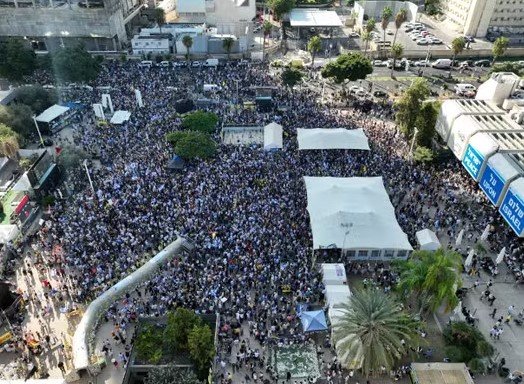Crowds in Tel Aviv burst into cheers and tears on October 13, 2025, as the last 20 living Israeli hostages returned home after more than two years in Hamas captivity. This milestone came through a US-brokered ceasefire and prisoner swap that also freed nearly 2,000 Palestinian detainees, marking a potential end to the Gaza conflict that started in October 2023.
Joyful Scenes Unfold in Hostage Square
People gathered in massive numbers at Hostage Square, a spot that has become a symbol of hope and protest during the long ordeal. As names of the freed hostages echoed from loudspeakers, families hugged strangers, and songs of celebration filled the air. Live footage on a giant screen showed the hostages crossing into Israel, handed over by Hamas to the International Committee of the Red Cross.
The atmosphere mixed relief with raw emotion. One onlooker, a young woman named Tal, shared her thoughts amid the crowd. She described the day as a miracle after endless worry. Many held yellow ribbons, a sign of solidarity for those held captive since the October 7, 2023, attacks.
This event capped 738 days of uncertainty for the hostages’ families. Protests in the square had pushed Israeli leaders to prioritize their release. Now, with all living captives back, the focus shifts to healing.

Details of the Ceasefire and Swap Agreement
The deal, mediated by US President Donald Trump, required Hamas to release all remaining living hostages and some remains in exchange for Palestinian prisoners. Israel agreed to free about 1,950 people, including some serving life sentences for serious crimes.
Negotiations stretched over months, with earlier partial releases building momentum. The final agreement included a ceasefire, allowing aid into Gaza and troop withdrawals. World leaders hailed it as a step toward lasting peace in the region.
Key elements of the exchange included:
- Release of 20 living Israeli hostages, many abducted during music festivals or from homes near Gaza.
- Freedom for Palestinian prisoners, some held without trial since the war began.
- Exile for certain high-profile detainees to other countries to prevent security risks.
This swap echoes past deals but stands out for its scale and the involvement of international brokers.
Stories of the Freed Hostages
Among those released were people from various walks of life, each with a harrowing tale. For instance, some young adults taken from a festival described months of isolation and fear. Older captives spoke of health struggles in poor conditions.
Families rushed to military bases for reunions, where medical teams waited to provide care. Psychologists prepared support programs, knowing recovery could take years. Compensation plans from the Israeli government promise millions in aid for therapy and rebuilding lives.
One table below outlines some of the freed hostages and their backgrounds:
| Name | Age | Background | Time in Captivity |
|---|---|---|---|
| Matan Angrest | 25 | Festival attendee | 738 days |
| Gali Berman | 28 | Kibbutz resident | 738 days |
| Ziv Berman | 30 | Kibbutz resident | 738 days |
| Alon Ohel | 24 | Musician | 738 days |
| Eitan Mor | 26 | Student | 738 days |
| Omri Miran | 27 | Engineer | 738 days |
These individuals represent just a fraction, but their stories highlight the human cost of the conflict.
The release also brought back remains of others, allowing families to hold funerals and find closure.
Palestinian Prisoners Return Home
On the other side, buses carried freed Palestinians to Gaza and the West Bank. Crowds welcomed them with flags and chants, seeing the exchange as a victory after years of tension.
Many released were young men detained during military operations. Some had served long sentences for attacks on Israelis. The deal specified that certain individuals would leave the region to avoid reigniting violence.
This part of the agreement drew mixed reactions. Supporters viewed it as justice, while critics worried about future threats. International monitors oversaw the process to ensure fairness.
Global Reactions and Path Forward
Leaders worldwide praised the breakthrough. Trump called it a historic dawn for the Middle East, crediting tough diplomacy. Other nations, including Qatar and Egypt, played roles in talks.
Yet challenges remain. The ceasefire is fragile, with both sides watching for violations. Aid groups push for more humanitarian access to Gaza, where rebuilding is urgent after widespread destruction.
Experts predict economic boosts from peace, like renewed trade and tourism. However, deep mistrust lingers, and full reconciliation could take generations.
What This Means for Lasting Peace
The exchange opens doors for broader talks on Gaza’s future. Israel seeks security guarantees, while Palestinians demand statehood progress. Recent events, like similar deals in other conflicts, show that dialogue can work.
Analysts note this deal’s timing aligns with global shifts, including US elections and regional alliances. If it holds, it could inspire solutions elsewhere.
As the dust settles, many hope this marks the end of a painful chapter. Share your thoughts on this development in the comments below, and spread the word to keep the conversation going.
